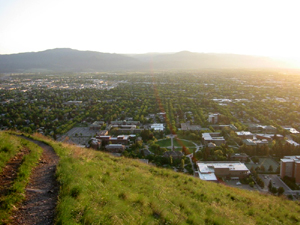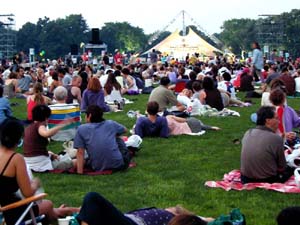|
How Can I Find and Help Build
a Walkable Community - continued
 |
Finding the Great Walkable Community.
My wife, Lys, and I left Central Ohio the day after we got
married in June, 1970 and moved west in search of a great
place to live. We struck gold, almost by accident, in our
first search for a town. We settled into and lived in Missoula,
Montana without a car for nearly ten years, very happy, healthy,
and highly engaged with every level of community life. We
knew, felt ownership and took pride in the many good places.
We walked and watched over green, canopied streets almost
everywhere. We felt the courtesies of drivers who watched
out for us. We knew each park, each of the five valley neighborhoods
and other places in the pre-sprawl portions of town. |
| |
|
It seems we came to know everyone, and everyone
knew us. We had many dozens of friends and hundreds, if not
thousands of associates. During our evenings we bicycled into
and up the Rattlesnake Creek, Grant Creek, Pattee Canyon,
the Hells Gate or, when we had the time, out to French Town
or Lolo. Our first child, Jodi, who maintains this web site,
was born there. Our small company, Bikecentennial (now Adventure
Cycling), was started there 25 years ago, and is still a small
but healthy addition to the local economy. |
| |
| Missoula has a healthy downtown. In the summer a
weekly farmers market is held on Saturdays. Many hundreds
of people walk or bicycle in to buy their fruit filled
pastries, breads, fresh fruits, and organic vegetables.
Others come for coffee, listen to music, watch people
dance, or just visit. Missoula also has a Friday noon
gathering on the rebuilt Clark’s Fork River front.
People come almost like a weekly pilgrimage for more
food, more music and more fun. And just across the street
from our little red ginger bread house at 317 Beverly,
in Bonner Park, people came on Wednesday nights to hear
the small but good community band. Some who bring their
cars to these events park them blocks away, some too
embarrassed to be seen arriving by car, but not knowing
the beauty of walking there. |

|
|
| |
|
One immigrant, poor in money, rich in pride
of being an American, conceived and built with his own hands,
along with the 50-60 volunteers he and former Mayor Daniel
Kemmis brought together, the newest and best post WWII carousel
in the nation. Missoula also boasts a variety of pricing and
sizing of housing stock, great waterfront and trails and a
pleasant college campus.
Like many Walkable Communities, today Missoula is also a
hearty sprawl place. One only has to look to the down slopes
of the mountains to see the ugly brutality of unregulated,
un-walkable growth patterns. But Missoula, like all vision
directed towns, has and continues to build upon its walkability,
while other parts of the same town and county hold contempt
for walkability, watering down, isolating and making more
distant healthy lifestyles in order to cash into the hungry
car culture, complete with all of its demands and droppings.
 |
Like many good places, Missoula is a town highly
conflicted, ever in balance. Goodness is not always
understood by all people living in a place. There are
many short-term investors milking and robbing from long-term
accomplishments. It is all too easy for decision makers
to close down good, well located and sized schools,
healthy and vital local parks, and well located small
churches, grocery stores or other retail in order to
build big. It always appears to be cheaper to provide
the same function on the bigger and cheaper parcel farther
out. These farther out places are locations where cars
appear to be happy. These outward parcels are cheaper
yes, but as we destroy the essences of a good neighborhood,
forcing ourselves into a car to have what we need we
whittle away the many reasons we came to invest here
in the first place. If you move to a walkable community,
you must understand its value then learn the skills
of building and defending it’s goodness.
Places more abandoned of walkability, health and vitality
have few conflicts. Their sense of place, pride, community
values have been lost, or chased away. |
All towns in our nation have some degree of walkability.
Some hold less than 5%, where microscopes are needed to find
the remaining shredded and often buried fragments. Some, such
as Littleton, New Hampshire, where they are too poor to afford
sprawl, have nearly 98% walkable scale and features. When
you find a town with good walkable features, such as Keene,
New Hampshire, you keep returning to recharge. I know I do.
I go back often, settle into a nice center town hotel, hang
out at local eateries, listen to the town chatter, walk the
main street day and night, over and over 2-4 days at a time. |
Previous | 1
| 2 | 3 | 4
| 5 | 6 |
Next
|
Walkable
Communities.,
33 E. Pine Street, Orlando, FL 32801 (866) 347-2734
For any comments, questions or suggestions about the content of
this web site please email: Ken Owens
Last Updated:
April 22, 2005
|
|



